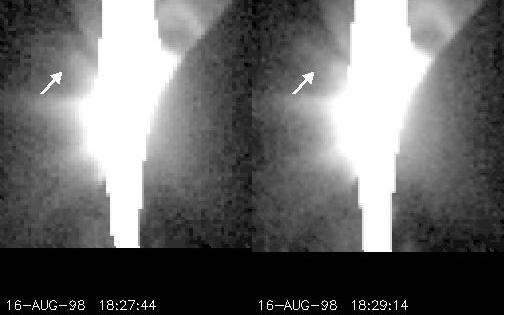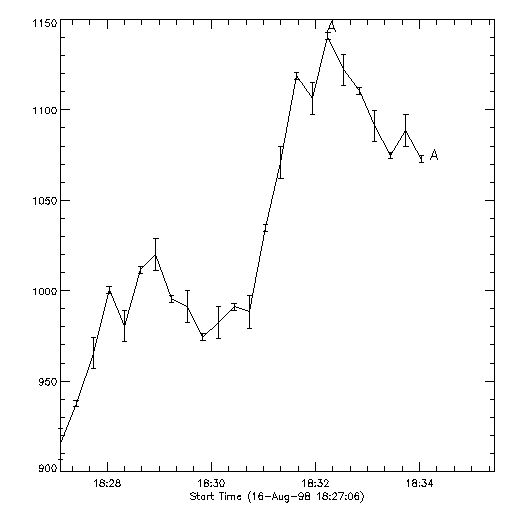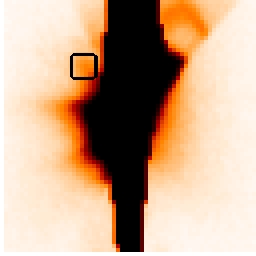Chromospheric Evaporation in Flares
One answer is, the plasma has been injected into the coronal loops from below. The lower levels of the atmosphere, the chromosphere and photosphere, have much higher plasma density and can provide a source of material for the coronal loops. The mechanism most often invoked for moving that material into the coronal is chromospheric evaporation. The idea is that very energetic particles, accelerated in the coronal portions of the magnetic loops, are channeled down to the footpoints of the loops where they impact the much denser chromosphere. The chromospheric material is intensely heated, and evaporates back up into the coronal portion of the loops. (A pressure imbalance is created by the intense heating, and the "evaporated" chromospheric plasma moves up the legs of the loops to reconcile the imbalance.)
Now this very hot evaporated plasma will emit X-rays, and that's how we see coronal loops -- because they're filled with the hot plasma. See last week's nugget for an example.
The impact of particles at the footpoints is evinced by heating of the plasma, leading to the familiar 2-ribbon signature in H-alpha and bright emission in ultraviolet and EUV. More directly, the deceleration of the particles results in hard X-rays emanating from the footpoints. Double sources of hard X-rays (one source at each footpoint) is a pretty clear indication of magnetic connectivity, and one of Yohkoh/HXT's important observations -- a previous nugget about the 2000 Bastille Day flare gives a particularly beautiful example. The co-location of hard X-ray sources with the H-alpha ribbons is further indication of chromospheric evaporation.
As for material flowing up along the legs of the loops, the signature you'd be looking for is a blueshift in the emission -- Doppler shifting due to the plasma moving towards your telescope. Yohkoh/BCS has been a marvelous instrument for looking for shifts, joined by SoHO/CDS+SUMER. Especially pertinent to this discussion is the observation by Wuelser et al. indicating blueshifted soft X-rays (hot stuff moving up the legs) coincident with redshifted H-alpha (chromospheric stuff being compressed at the feet).
Know too that as the plasma is emitting this EUV and X-radiation, the plasma is cooling. In another parallel to the water cycle, let the plasma cool enough, and it will condense and fall back down to the chromo/photosphere. There's observational signatures of this too -- perhaps the most concise is the one shown below, taken from a 1999 paper by Czaykowska et al. SoHO/CDS data taken during a two-ribbon flare revealed simultaneous blueshifts in the outer edges of the ribbons, and redshifts at the inner edges:
|
640 kbyte GIF |
|
75 kbyte MPEG |
Please note that all the images in this sequence were made with the same filter, and with the same exposure duration. The brightening you see here is not an artifact, it's real. We happened to catch it this time because of a combination of (i) early flare-mode trigger, and (ii) exposures short enough that the arcade appears faint in the first several frames.
A very important point must be made about this movie: the arcade loops seem to brighten in place -- there is some residual motion, but for the most part the loops have achieved their equilibrium positions before filling up with hot plasma. If the reconnection model of flares is correct, then this means that the reconnected field lines have performed their shrinkage, relaxing whatever magnetic tension was extant after the reconnection, on a time scale that is significantly shorter than the evaporation timescale. That is, "the loops shrink faster than they fill up".
As an aside, I'd like to point out that the residual motion in the above movie, particularly in the northern part of the top of the arcade, appears to be downward, as if the top of the arcade is being retracted -- not upward as pictured in certain high-Beta disruption models.
More than ten minutes is required for the loops in the above movie to reach full brightness, suggesting that chromospheric evaporation can be quite slow. This points to the reason why reconnection outflow has been so hard to observe: the loop shrinkage is finished, and the dipolarization of the loops is completed, while the loops are still invisible.
Now that I've planted that picture in your mind, look at the following movie. It's from a flare on 16 August 1998, and shows an arcade that was observed by Yohkoh SXT. The solar limb is the gentle curve starting in the upper right, and the big vertical smear is due to pixel saturation. Look specifically at the region pointed out by the arrow.


|

|
Chromospheric evaporation is an important component of solar flares, as evidenced by numerous observations. If the magnetic reconnection model is an accurate description of flares --- and many think that it is --- then the reconnection outflow is ordinarily going to transpire faster than the observable effects of evaporation. This is consistent with many years of observations, and indeed is one of the reasons that reconnection outflow has been difficult to confirm. Bearing this in mind, the 16 Aug 1998 observation is suggestive of a situation in which the magnetic loop shrinkage is slow enough, and the chromospheric evaporation sufficiently vigorous, that the hot plasma begins to reach the apex of the loop before the shrinking loop has reached its final, nearly dipolar position. As this kind of supra-arcade downflow cannot be explained as cool material (it's X-ray emitting), nor as high-Beta disruption, it should be considered another piece of Yohkoh support for reconnection.
October 18, 2002
David McKenzie mckenzie@mithra.physics.montana.edu